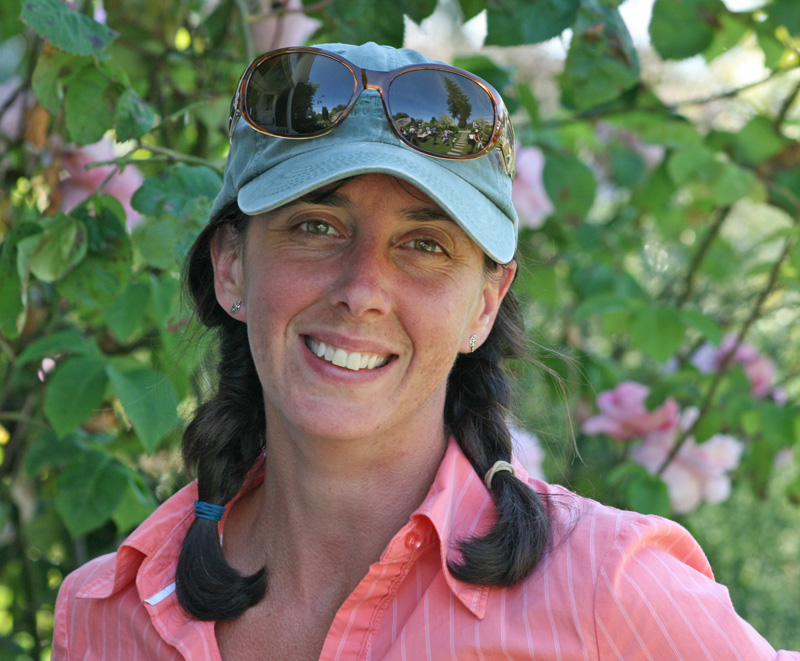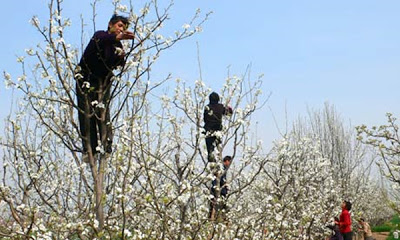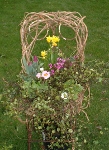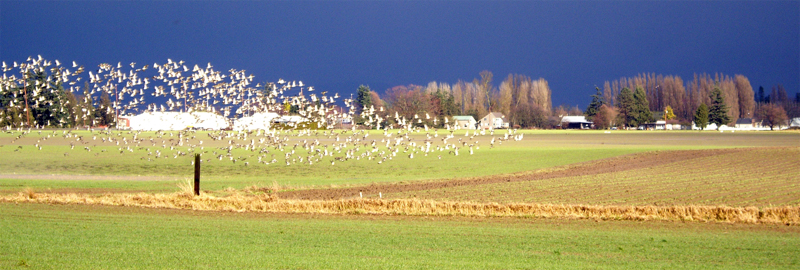|
|
|
March 2014
|
Vol 3, Issue 11
|
|
Garden Notes

|
|
|
|
|
|
Greetings from Christianson's!
|
 | |
Image courtesy of LoveLaConner.com
|
The daffodil is our doorside queen, She pushes upward the sword already, To spot with sunshine the early green.
~William Cullen Bryant
March is the transitional month for gardeners. It's the month where one gardening foot is in the garden (with the woollies and Wellies on) and one foot is still tucked under the table while you peruse through seed catalogs and garden books in the depth of planning things out. When it's nice out, the ground can still be frozen. The thaw starts in earnest towards the end of the month when the daffodils and hyacinths start poking up out of the ground in bright green anticipation. That's when you know that spring is right around the corner.
March is also the time to get the last of the winter chores done. Buds haven't broken yet, so there's still time to do that last minute pruning. If you have old fruit trees that have lost their mojo, Ani Gurnee is teaching a class on Renovating Old Fruit Trees that will give you great tips on getting the fruit production back in order (and motivate you to get that pruning saw out to do it).
If you're after design inspiration, Kathy Hirdler's class The Shade Garden will provide plenty of it. Who doesn't have at least some shade in their garden around here and Kathy will demonstrate that it doesn't have to look lackluster and boringly green (or for that matter, brown if it's dry shade). Now is the time when the ephemeral plants are emerging and many of them grow in shade, providing bits of color with delicate blooms. Also, many rhododendron species will soon be blooming. Bob Zimmermann of Chimacum Woods is offering a class, Species Rhododendrons: Not Your Father's Rhodies. Bob will demonstrate that species rhodies, in addition to great looking blooms, vary widely in leaf textures and sizes that give year around interest in the garden.
Take advantage of this month for special projects you've always wanted to do, but just hadn't gotten to yet. We have several workshops that are sure to boost your creativity.
What better way to get inspired than to take a hands-on class creating Bonsai. Tori Lenze of Buddha Belly Bonsai will be teaching a Beginning Bonsai Workshop this month. Tori will instruct you on how to transform a small shrub into a beautiful Bonsai tree. All materials are included in the class fee! Just bring yourself, gloves and a small set of pruners or nippers. We will also have traditional tools and additional materials available for purchase.
Our Laura Campbell is teaching a workshop utilizing all those prunings you've recently accumulated by incorporating them into a chair for a fabulous garden accent! What to Do with Spring Prunings? Here's a New Twist! is a great way to use that old chair lying around that has never made it to the thrift store. Don't have an old chair? You can probably find one at ....well....the thrift store. Paint that chair a great accent color ahead of time to make the applied woven branches visually pop.
Speaking of re-purposing, we are pleased to have Zsofia Pazstor teach a class on gardening sustainably and purposefully. Landscaping with a Purpose, will provide you the opportunity to learn how and why it is important to incorporate low impact development principles for water quality and wildlife when creating a beautiful landscape. Zsofia is the owner of Innovative Landscape Technologies where she specializes in low impact development solutions. She is also President of Farmer Frog, a regional nonprofit organization in the Puget Sound area teaching, supporting and promoting intense and innovative urban agriculture and sustainable food production. She teaches sustainable landscaping and urban agriculture classes at Edmond's Community College and is an independent consultant, having been past President of the Sustainable Development Task Force in Snohomish County. Just looking for a way to get some fresh air and (hopefully) sunshine? Then join John Christianson at the end of the month for his early Spring Garden Walk through the lovely, British inspired gardens of La Conner Flats. With so much to do and classes to choose from, March at the Nursery should be a great month for you to shake off those winter gardening cobwebs.

Debra Lacy,
Certified Professional Horticulturist & Editor
|
|
 |
|
Where To Find Us
| |

15806 Best Road
Mount Vernon, WA 98273
Map and directions
www.christiansonsnursery.com
360-466-3821
1-800-585-8200
Spring Hours
Starting March 1
Open daily 9 am - 6 pm
Weekly Radio Broadcast:
Sunday Mornings at 10:30 am
The Garden Show
with John and Mike
KAPS AM 660
Voted Best Greenhouse and Nursery
in Skagit Publishing's
People's Choice Awards for
2010, 2011 and 2012
NW Flower & Garden Show
"People's Choice Award 2011"
Special Events
John Christianson will be teaching a class on
Rose Gardening in the PNW,
Saturday, March 8 at the
Whidbey Gardening Workshop

|
|
|
|
Seasonal Specials
|
MARCH SPECIALS March 1-16
Bare Root
The best selection of the year!
Fruit, flowering and shade trees, berries,
lilacs and hydrangeas
20% off Already low bare root prices
Click here for planting instructions for bare root plants March 17-31 Camellias
Winter and spring flowering beauties
Many still in bloom!
20% off
|
|
|

Upcoming Classes & Events
.: MARCH :.
Saturday, March 1
11 am: Espalier Pruning Sunday, March 2
1 pm: The Shade Garden Saturday, March 15
11 am: Renovating Old Fruit Trees Sunday, March 16
1 - 3:30 pm: Beginning Bonsai Workshop Saturday, March 22
1 - 2:30 pm: Workshop: What To Do with Spring Prunings? Sunday, March 23
1 pm: Landscaping with a Purpose
Saturday, March 29
11 am: Species Rhododendrons: Not Your Father's Rhodies
Saturday, March 29
1 pm: Spring Walk with John Christianson
These classes are very popular and fill up quickly. Please call us soon to reserve your spot at 1-800-585-8200.
.: MARK YOU CALENDARS FOR THESE UPCOMING EVENTS :.
April 5 - 27
10 am - 5 pm, daily: Art at the SchoolhouseSaturday, April 26 10 am - 3 pm: Rhododendron Truss Show Saturday, June 21 9 am - 5 pm: NEW! First Annual Antique Fair at the Schoolhouse Saturday, June 28 9 am - 6 pm: 11th Annual Rose Festival
For more information visit our web site at
|
The Garden in March
by Rachel Anderson
|
 | |
Cardamine hirsuta
|
Over the winter I took advantage of the "off" season by taking a few classes (actually, a lot of classes!) in hopes of honing my skills as a gardener and exposing myself to new ideas. They ranged from raising goats to keeping honey bees and from identifying garden pests to heirloom vegetables that do well in the PNW. However, one class that still gets me kind of excited (well, ok- they all got me pretty excited and inspired) was one about edible weeds.
Read more......

Rachel has been gardening since childhood, thanks to her mom, and has been part of the team at Christianson's since 2002. She's a Certified Professional Horticulturist with a passion for roses and vegetable gardening. Rachel and her family enjoy gardening together and now share their urban garden with a menagerie of ducks, chickens, two cats, and a dog.
|
|
| |
Have you ever noticed how many different types of bees there are in your garden? There are around 4000 native species of bees in the U.S.! In the home garden alone you might see small blue mason bees, green iridescent bees, black bees with wings like stained glass, leaf-cutter bees, and bumblebees. They are all important for crop pollination, and fascinating to watch in action. And they are in trouble!
If you would like to support your local bee population, and "hire" more bees to work inside your garden, be sure to avoid using pesticides, especially systemic types and plant a wide variety of bee-friendly flowers and flowering herbs. We carry several collections of flowers seeds that will support and help our bees survive and thrive. Botanical Interest's Save the Bees contains Organic Bachelor Button Dwarf Blend, Organic Borage, Hyssop Lavender, Lavender Hidcote Dwarf and Organic Sunflower Lemon Queen Organic among others.
We also carry Uprising Seed's Bee's Friend and Ed Hume's Wildflower Mix. If everyone devoted a small area of their garden to bees, the bee population would 'bee' a lot healthier. It's in everyone's interest to support bees because without them, we wouldn't have most of the crops we love to eat.
One area in China has already learned, too late, the importance of bees. Indiscriminate use of pesticides has eliminated their bees and they have had to resort to hand pollinating their apple trees for the last two decades! If we don't save our bee populations, we will end up doing this:

|
|
Great Design Plants
| |
Alas, March Blooms!
This is the month when a profusion of white to light pink flowers blanket the landscape in a glorious display, still before leaves emerge. Here are a few great plants for March interest:
Trees & Shrubs
Abeliophyllum distichum 'Roseum': Commonly known as the Pink Forsythia, this cousin has lovely clusters of fragrant, pale pink flowers that appear before the leaves, providing a beautiful display before most other flowering shrubs. Grows 3 - 5 feet tall and wide in sun to part shade. Provide a dark green background for best show in shrub borders or use as an informal hedge. Deciduous. Hardy to -20 degrees (F).
Chaenomeles speciosa: Commonly called flowering quince, this is a dense, broad-rounded, deciduous shrub with often tangled, spiny, gray-brown branches. It typically grows to 6-10' tall and as wide. Scarlet to red (less frequently pink or white) five-petaled flowers bloom before the leaves fully unfold in an often showy early spring bloom. Flowers are followed by hard, dot-speckled, edible, yellowish-green fruits (2.5" quinces) that are rather bitter when eaten fresh from the shrub, but quite tasty in preserves and jellies. Proven Winners has recently introduced a new series called Double Take ™ with large double flowers on a compact form that only gets to 4' tall and wide and we currently carry 'Pink Storm' and 'Orange Storm'. C. x superba 'Cameo' is an old favorite, noted for its double peach-pink flowers and compact shape. Hardy to -30 degrees (F).
Magnolia stellata 'Royal Star': Magnolia stellata, commonly called star magnolia, is native to Japan. 'Royal Star' is a popular cultivar that has slightly larger and showier flowers than the species. It is a small deciduous tree that typically grows 15-20' tall with a spreading, rounded crown. It is also often grown as a large oval to rounded shrub. It is noted for its compact size and late winter to early spring bloom of star-shaped lightly fragrant white flowers. Easily grown in average, medium, well-drained soil in full sun to part shade. Prefers rich, organic soils. Best in a location sheltered from high winds, except avoid protected southern exposures where the buds may be induced to open too early. Hardy to -30 degrees (F).
|
|
|
| |
Abeliophyllum distichum 'Roseum'
|
Chaenomeles x superba
'Cameo'
|
Magnolia stellata
'Royal Star'
|
Osmanthus delavayi: Combining tiny, very dark green leaves and small, fragrant, tubular white flowers, this evergreen shrub provides year-round interest. Blooming in late winter to early spring, its flowers perfume the garden. Adaptable and flexible, Delavayi's osmanthus can be clipped to form a hedge or screen or left to grow naturally. Grows 5 feet tall and 7 feet wide, but will get bigger with age. This plant will grow in full sun to shade and is drought tolerant, once established. Combine it with shrubs with larger or paler leaves. This plant has a great track record: Its was collected by Abbe Delavay in 1890 in Sichuan and Yunnan and sent to a French nursery for introduction. Hardy to 0 degrees (F).
Spiraea x vanhouttei: Vanhoutte spirea is a vase-shaped, deciduous shrub with branching that arches gracefully toward the ground. It is a hybrid cross between S. trilobata x S. cantoniensis. It typically grows 5-8' tall with a spread to 7-10' wide. It is particularly noted for its showy spring bloom. Tiny white flowers appear in late March to April in umbellate clusters that profusely cover the leafy branching. Easily grown in average, medium moisture, well-drained soils in full sun. Tolerates light shade, a wide range of soils and some drought. Prune as needed immediately after flowering. Fall color is usually undistinguished, but attractive purplish hues may sometimes develop. Specific epithet honors Belgian nurseryman, L. B. Van Houtte (1810-1876). Hardy to -30 degree (F).
Stachyurus praecox: It's rare to find this plant in the landscape, which is unfortunate because Stachyurus praecoxis a great deciduous shrub that is perhaps best noted for its unique and colorful late winter to early spring flowers that bloom before the foliage emerges. Flower buds form in autumn and overwinter on the plant in pendant, catkin-like racemes that hang from the leaf axils. Each flowering raceme (to 4" long) typically has 10-20 tiny, bell-shaped, 4-petaled, yellow-green flowers. Flowers bloom in March-April. This shrub typically grows to 4-6 feet (less frequently to 10 feet) tall with an open, upright, arching-spreading habit. During the growing season, attractive red-brown to chestnut-brown branches are clothed (sometimes sparsely) with serrate, medium green leaves (to 7 inches long!). Best grown in light, humusy, acidic, moist but well-drained soils in full sun to light shade. Specific epithet means early. Hardy to -10 degrees (F).
|
|
|
| |
Osmanthus delavayi
|
Spiraea x vanhouttei
|
Stachyurus preacox
|
Bare Root Fruit Trees and Shrubs - Locally Grown in the Skagit Valley
March is still prime time to plant and prune your favorite edible trees and shrubs because they come to us bare root. Bare root plants are easy to plant, adapt well to your garden conditions and provide an abundance of fruit for your table and they cost 30% less than their counterparts sold in pots. We have many different varieties of apples, pears, cherries, frost peach, blueberries, raspberries, currents and brambles. Herbaceous Early Spring Bloomers
Narcissus 'Mount Hood': Nothing trumpets the arrival of spring like the early blooming daffodils and Narcissus'Mount Hood' positively glows in the late winter garden. A sturdy, 18 to 20-inch stem holds 4 inch white trumpet flowers. Planting 'Mount Hood' bulbs in groups provides a natural look in the landscape and Hostas and deciduous ornamental grasses are a good combination because they will cover/disguise the foliage of the Narcissus as it dies back by early June. Narcissus grows best in full sun to light or open shade. Plant the bulbs in moist to well-drained soil, although they will tolerate sand and clay. Hardy to -30 degrees (F).
Anemone nemerosa: This low growing, spreading colonizer is a delight in the early spring landscape. In late winter finely cut foliage emerges followed by brightly colored single flowers in shades of blue, purple, pink or white. Given time, impressive carpets can form, creating quite a spring display. Wood anemone adapts to a wide range of soils including sand and clay, but prefers a well-drained location. Flowering is most profuse in full sun to light or open shade. New leaves emerge in late winter and remain until mid-summer. When foliage begins to yellow and die back it can be cut to the ground. It is drought tolerant and remains dormant during the dry summer weather. Underground rhizomes can be divided from early summer to late winter. Hardy to -20 degrees (F).
Epimediumm pinnatum ssp. colchicum 'Black Sea': This iron-clad perennial is handsome and easy to grow. From late winter to early spring Epimedium 'Black Sea' produces a profusion of small, delicate-looking flowers dancing on the tips of thread-thin red stalks. New leaves soon follow the dainty blooms and mature to an attractive blue-green. The most remarkable feature of the foliage is the inky purple-black coloring that 'bleeds' into each leaf with the onset of cooler temperatures and frost. This deep coloring lasts until the new leaves emerge next spring. Plant it with pale-colored hellebores to accentuate the unusual winter foliage. Grows to just over a foot tall and is spreading. A great plant for dry shade. Hardy to -20 degrees.
|
|
|
| |
Narcissus 'Mount Hood'
|
Anemone nemerosa
|
Epimedium pinnatum
'Black Sea'
|
|
Primrose Antiques & Gifts
|
Our delicate, clear glass vases come in an array of styles to display your
spring garden blooms!
|
|
Aquiesse candles use designer, nature-inspired fragrances made from
the purest soy and highest grade essential oils to quickly scent your
space with a clean and even burn.
|
|
|
Fresh Ideas
|
Here's an assortment of fun ideas, helpful tips and great recipes for March. Simply click on a photo you like (or the link below the photo) to learn more. We hope you enjoy this month's collection of fresh ideas! |
|
Upcoming Classes & Events
|
Back to Calender Highlights
.: MARCH :. 
Saturday, March 1
Espalier Pruning
11 am - Noon
(reservations required - $8 class fee)
Learn how to create and maintain beautiful Espalier fruit trees. Ani Gurnee of Aulos Design will take you through the steps that will help ensure good form and success with this age old pruning form. Learn what ornamental trees and shrubs also take well to Espalier.
Saturday, March 2 
The Shade Garden
1 pm - 2 pm
(reservations required - $8 class fee) 
Shade gardening may seem like a challenge with so many perennials, shrubs and trees demanding full sun to perform. However, the spring and fall shade garden can be full of flowers. Whether under deciduous or evergreen trees, or on the north side of buildings, learn how to best fill your shady places with beautiful foliage and flowers that thrive in these special places throughout the growing year. Realize the potential of these areas for calm, even meditative garden areas. Join Kathy Hirdler Floribunda Designs of in discovering the joys of shade gardening in our great Northwest.
Saturday, March 15 
Renovating Old Fruit Trees
11 am - Noon
(reservations required - $8 class fee)
Over time, fruit trees can lose vigor or suffer the consequences of neglect. Ani Gurnee of Aulos Design will explain the benefits of renovating old fruit trees and the best approach and techniques to use in order to achieve added production in your trees. Sunday, March 16 
Beginning Bonsai Workshop
1 pm - 3:30 pm
(reservations required - $86 class fee, includes matierials. Class size limit - 12)
Learn hands-on basics of creating a beautiful bonsai from expert, Tori Lenze. Students will learn how to design and transplant a tree and how to use different tools for shaping. Class fee includes all materials including bonsai pot, plant, soil and screening. Students bring small pruners, scissors and gloves. Additional tools and supplies available for purchase. Saturday, March 22 
Workshop: What To Do With Spring Prunings? Plant a Chair.
1 pm - 2:30 pm
(reservations required - $40 class fee, some materials included)
 Join Laura Campbell, renowned wreath weaver, as she guides you through the making of a living chair for your home or garden. Bring your own chair (wood or metal), preferably with an open back or seat and don't forget pruners and gloves! We'll provide the vines and planting infrastructure and with expert guidance you'll weave around the chair creating the "bones" to support your plantings. A little chicken wire and moss provide the "pot." When you're done, stroll the nursery to select and purchase the plants for your new garden chair! Join Laura Campbell, renowned wreath weaver, as she guides you through the making of a living chair for your home or garden. Bring your own chair (wood or metal), preferably with an open back or seat and don't forget pruners and gloves! We'll provide the vines and planting infrastructure and with expert guidance you'll weave around the chair creating the "bones" to support your plantings. A little chicken wire and moss provide the "pot." When you're done, stroll the nursery to select and purchase the plants for your new garden chair! Sunday, March 23 
Landscaping with a Purpose
11 am - Noon
(reservations required - $8 class fee)
 In the 21st century, gardens and landscapes are called to be more than beautiful spaces filled with color and fragrance. Today's gardens are stormwater facilities that produce renewable and basic resources, prevent erosion, benefit air quality, feed their inhabitants both critters and people and mitigate habitat for wildlife. Come and learn why and how from Certified Low Impact Development specialist Zsofia Pasztor, to transform your garden to a modern environment! In the 21st century, gardens and landscapes are called to be more than beautiful spaces filled with color and fragrance. Today's gardens are stormwater facilities that produce renewable and basic resources, prevent erosion, benefit air quality, feed their inhabitants both critters and people and mitigate habitat for wildlife. Come and learn why and how from Certified Low Impact Development specialist Zsofia Pasztor, to transform your garden to a modern environment! Saturday, March 29
Species Rhododendrons: These Are Not Your Father's Rhodies!
11 am - noon
(reservations required - $8 class fee) Bob Zimmermann of Chimacum Woods will explore the distinctly different world of species rhododendrons.
These plants don't look like the rhodies most of us are used to. They offer a broad range of leaf shapes, colors and patterns. Bob, has been raising species rhodies from seed for forty years and has just returned from his fifth rhody exploration in China. He will describe and show pictures of some of the most interesting species, including many available at the nursery.
Saturday, March 29 
Spring Garden Walk with John Christianson
1 pm - 2 pm
(reservations requested - Complimentary)
Join John Christianson for his first tour of the year through the lovely English style gardens of La Conner Flats located next to the nursery. Meet John in front of the schoolhouse then stride over to La Conner Flats to see what plants are showing an inspiring early spring display. Waterproof shoes and raingear are recommended depending on the weather. Classes fill up fast so reserve your spot soon.
Please call us at 360-466-3821 or 1-800-585-8200
|
|
Closing Thought...
|
 | |
Photo by Debra Lacy
|
In the midst of winter, I found there was, within me, an invincible summer.
~Albert Camus
|
|
|
|
Garden Notes Editor:
Debra Lacy, Public Relations
Christianson's Nursery & Greenhouse
360-466-3821
|
|
|
|
|
|